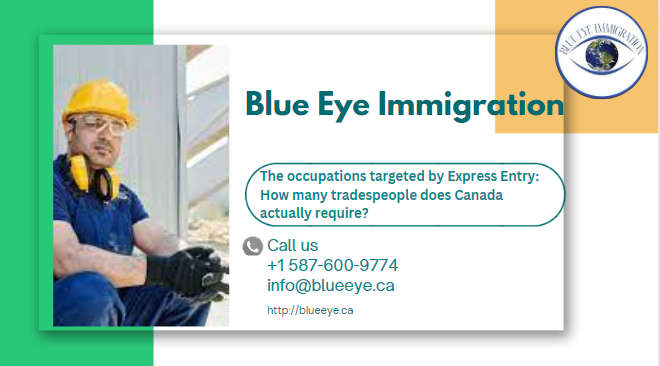One of the five occupational groups that Immigration, Refugees and Citizenship Canada (IRCC) has decided to give priority to through category-based Express Entry drawings in 2023 is trades.
The Canadian federal government launched Express Entry category-based drawings earlier in 2023 as a way to use immigration to alleviate labor market shortfalls in five selected occupational categories*.
Health care, STEM fields (science, technology, engineering, and mathematics), trades, transportation, and agriculture/agri-food are among the 2023 Express Entry categories.
The IRCC established category-based selection draws for Express Entry earlier this year to help important employment sectors that are experiencing some of the highest labor market gaps in our country.
On June 28, the first category-based draw for Express Entry was held. Since then, there have been four more category-based lotteries for these five occupational categories.
The focus placed on a candidate’s Comprehensive Ranking System (CRS) scores distinguishes the new category-based draws from the “standard” Express Entry draws. The more recent draws give candidates with particular job experience priority, while conventional draws primarily rank candidates using CRS scores.
Why Express Entry chose to target the field of trades
Said Employment and Social Development Canada (ESDC), “skilled trades are in high demand, rewarding, and essential to communities across Canada.” Additionally, ESDC predicts that more than 256,000 new apprentices would be required “over the next five years” to meet the demand for skilled crafts jobs in the country.
Additionally, between 2022 and 2026, “the Canadian Apprenticeship Forum estimates that over 122,000 new journeypersons will be required to sustain workforce certification across Red Seal trades in Canada,” according to a news release from the Government of Canada from August of this year.
The Red Seal program creates requirements and tests for Red Seal trades. A tradesperson who passes the Red Seal exam earns a Red Seal endorsement, which serves as documentation that they have attained the industry’s minimum requirements.
When considered collectively, these predictions and estimations support the Canadian government’s decision to prioritize trade workers’ immigration this year through category-based draws.
In addition to the demand forecasts provided above by the ESDC and the Canadian Apprenticeship Forum, BuildForce Canada predicts that by 2032, the construction industry will need to hire 299,200 new workers nationwide. This forecast is based on the expectation that 245 100 workers, or 20% of the workforce in this profession in 2022, will shortly retire.
Does Canada actually require that many tradespeople?
The Canadian Occupational Projection System (COPS) is an additional online tool run by ESDC. This tool predicts a nearly 20,000 increase in job vacancies for “trades helpers and laborers” in the occupational outlook between 2022 and 2031.
The next section explains in more detail how four distinct factors are anticipated to affect the number of new job vacancies within this occupational category in the upcoming years.
- The “expansion demand” will account for 3,400 (17%) of the employment vacancies.
- The “retirements” will result in 11,800 (60%) new job opportunities.
- The “other replacement demand” will account for 1,800 (9%) of the employment opportunities.
- 2,600 jobs (13%) will be available because of “emigration”
Together, these numbers show that Canada will need thousands of additional workers in skilled trade jobs to help address the labor shortages in this sector.
What chance does this give potential immigrants to Canada?
Candidates for immigration with experience in trades occupations were among the top receivers of Invitations to Apply (ITAs) for permanent residence in Canada last year, according to the 2022 year-end Express Entry report.
Together, these numbers show that Canada will need thousands of additional workers in skilled trade jobs to help address the labor shortages in this sector.
What chance does this give potential immigrants to Canada?
Candidates for immigration with experience in trades occupations were among the top receivers of Invitations to Apply (ITAs) for permanent residence in Canada last year, according to the 2022 year-end Express Entry report.
The top 15 principal jobs of Canadian immigrants who acquired an ITA in 2022 included Cooks specifically. This carries on a pattern from 2021. People in this profession were among the top five primary occupation recipients of ITA in that year.
This can be interpreted as evidence that the federal government intended to welcome immigrants to this nation who are capable of filling vacancies in the skilled trades labor market even before the implementation of category-based draws.
Add to this a moving statement from Ahmed Hussen, who will serve as Canada’s Minister of Housing, Diversity, and Inclusion through July 2023, which emphasizes the fact that immigrants to Canada have many job prospects in the trades sector.
In response to the housing issue in Canada, Hussen stated, “We actually need additional individuals, skilled immigrants, to also help us in the building trades and the construction sector of our economy. The employees must actually arrive and assist in the construction of the housing that Canadians require.
This appropriately gives cause to believe that prospective Canadian immigrants who enter the nation through category-based Express Entry draws for trade occupations may be able to build fulfilling careers.
Background of trades Draws for Express Entry to date
To present, IRCC has only sent out one set of invitations to eligible Express Entry applicants with recent trades experience.
On August 3, 1,500 immigrants with work experience in the trades were asked to apply for permanent residence in Canada. This draw took place at that time. For consideration in this draw, candidates needed a CRS of at least 388.
Data acquired from IRCC by the Globe and Mail just days before to this Trades category-based draw indicated that category-based draws for applicants with experience in trades jobs will account for “three to four” percent of all ITAs given under Express Entry for the remainder of this year.
To check the outcomes of each Express Entry draw held by the IRCC, click here. Every time a new draw takes place, the hyperlinked page will be updated.
